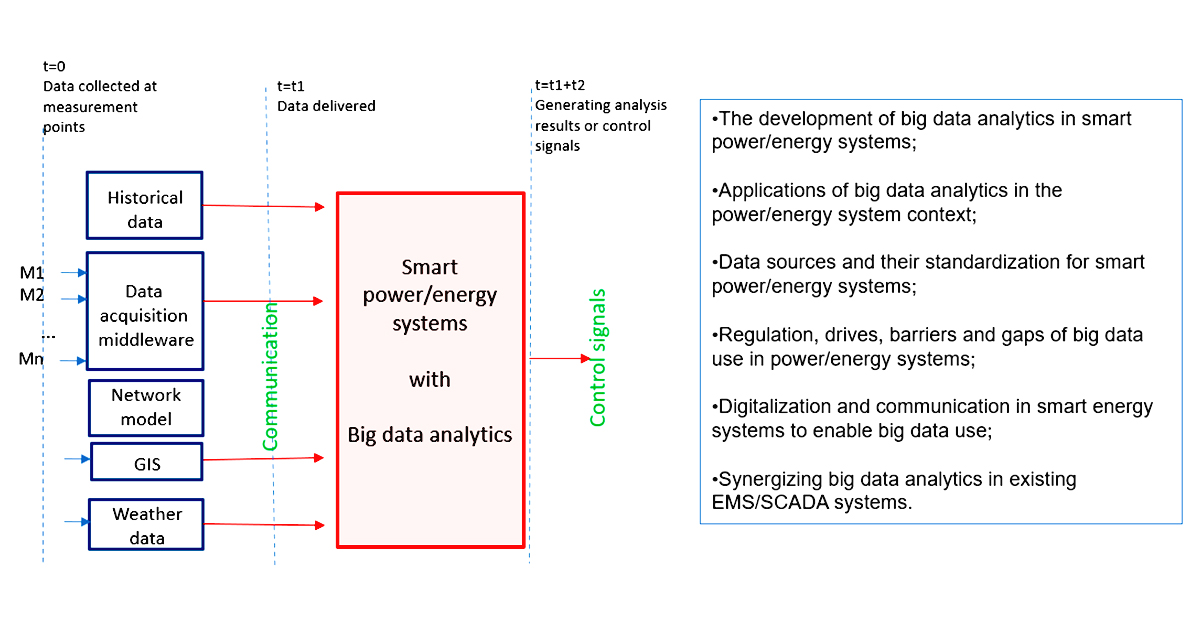Big Data Analytics for Smart Power/Energy Systems
A special issue of Energies (ISSN 1996-1073). This special issue belongs to the section "F5: Artificial Intelligence and Smart Energy".
Deadline for manuscript submissions: closed (30 March 2023) | Viewed by 10979

Special Issue Editor
Special Issue Information
Dear Colleagues,
Energy systems around the world are going through a tremendous transformation, driven by technological changes, carbon footprint, policy imperatives and energy efficiency. They become more and more complex with the widely distributed low-carbon technologies (e.g., EVs, energy storage, PV, wind turbines, heat pumps, etc.). To optimally manage this large number of energy resources, smart and flexible energy systems are essential.
Big data and data analytics play important and unreplaceable roles in achieving smart systems that can deliver significant economic and environmental benefits. At present, data are growing at an exponential rate in the power/energy sector (ranging from power grid levels to household levels), thanks to the rapid development of digital technologies. To generate value from this large amount of raw data, proper big data analytics are needed to process/analyze the data and extract useful information that can be integrated and used in the energy systems. With this urgent need, the development of big data analytics for smart system management/operation has attracted great interest in both academia and industry.
This Special Issue aims to present the macro-environment, cutting-edge technologies, methodologies and applications of big data analytics for smart energy systems. Topics of interest for publication include, but are not limited to:
- The development of big data analytics in smart power/energy systems;
- Applications of big data analytics in the power/energy system context;
- Data sources and their standardization for smart power/energy systems;
- Regulation, drives, barriers and gaps of big data use in power/energy systems;
- Digitalization and communication in smart energy systems to enable big data use;
- Synergizing big data analytics in existing EMS/SCADA systems.
Dr. Huilian Liao
Guest Editor
Manuscript Submission Information
Manuscripts should be submitted online at www.mdpi.com by registering and logging in to this website. Once you are registered, click here to go to the submission form. Manuscripts can be submitted until the deadline. All submissions that pass pre-check are peer-reviewed. Accepted papers will be published continuously in the journal (as soon as accepted) and will be listed together on the special issue website. Research articles, review articles as well as short communications are invited. For planned papers, a title and short abstract (about 100 words) can be sent to the Editorial Office for announcement on this website.
Submitted manuscripts should not have been published previously, nor be under consideration for publication elsewhere (except conference proceedings papers). All manuscripts are thoroughly refereed through a single-blind peer-review process. A guide for authors and other relevant information for submission of manuscripts is available on the Instructions for Authors page. Energies is an international peer-reviewed open access semimonthly journal published by MDPI.
Please visit the Instructions for Authors page before submitting a manuscript. The Article Processing Charge (APC) for publication in this open access journal is 2600 CHF (Swiss Francs). Submitted papers should be well formatted and use good English. Authors may use MDPI's English editing service prior to publication or during author revisions.
Keywords
- smart energy systems
- big data analytics
- smart grids
- low-carbon technology
- digitalization
- communication technologies in smart grids
- machine learning
- clustering, classification, characterization
- data mining
- feature extraction
Benefits of Publishing in a Special Issue
- Ease of navigation: Grouping papers by topic helps scholars navigate broad scope journals more efficiently.
- Greater discoverability: Special Issues support the reach and impact of scientific research. Articles in Special Issues are more discoverable and cited more frequently.
- Expansion of research network: Special Issues facilitate connections among authors, fostering scientific collaborations.
- External promotion: Articles in Special Issues are often promoted through the journal's social media, increasing their visibility.
- Reprint: MDPI Books provides the opportunity to republish successful Special Issues in book format, both online and in print.
Further information on MDPI's Special Issue policies can be found here.





